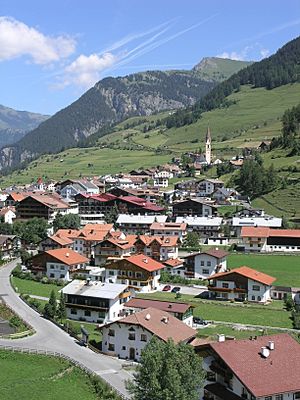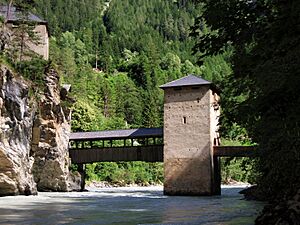Nauders facts for kids
Quick facts for kids
Nauders
|
||
|---|---|---|
 |
||
|
||
|
.
Location of Nauders within Tyrol
|
||
| Country | Austria | |
| State | Tyrol | |
| District | Landeck | |
| Area | ||
| • Total | 90.31 km2 (34.87 sq mi) | |
| Elevation | 1,394 m (4,573 ft) | |
| Time zone | UTC+1 (CET) | |
| • Summer (DST) | UTC+2 (CEST) | |
| Postal code |
6543
|
|
| Area code | 05473 | |
| Vehicle registration | LA | |
| Website | www.nauders.tirol.gv.at | |
Nauders (which is called Romansh: Danuder in Romansh) is a town in the Landeck area of the Austrian state of Tyrol. It's a beautiful place nestled in the mountains, known for its history and stunning views.
Contents
Geography and Location
Nauders is located in a high valley, which is like a flat area surrounded by tall mountains. This valley is part of the Ötztal Alps, just north of the main Alpine mountain range. The town sits at an altitude of about 1,394 meters (4,573 feet) above sea level.
It is about 29 kilometers (18 miles) south of Landeck, which is the capital of the district. Nauders is on a road that goes from Pfunds in the Inntal valley, through a narrow gorge called Finstermünz, and up to the Reschen Pass. This pass leads to the border with Italy and the Vinschgau region in South Tyrol.
Close by, you can find the point where the borders of Austria, Switzerland, and Italy meet. To the west, another road leads into the Sesvenna Alps and to Martina in the Lower Engadin valley in Switzerland.
Nauders Weather and Climate
The weather in Nauders changes with the seasons, like in many mountain areas. Here's a look at the average weather conditions:
| Climate data for Nauders (1971–2000) | |||||||||||||
|---|---|---|---|---|---|---|---|---|---|---|---|---|---|
| Month | Jan | Feb | Mar | Apr | May | Jun | Jul | Aug | Sep | Oct | Nov | Dec | Year |
| Record high °C (°F) | 9.9 (49.8) |
16.1 (61.0) |
19.0 (66.2) |
20.8 (69.4) |
27.0 (80.6) |
30.0 (86.0) |
31.6 (88.9) |
31.7 (89.1) |
27.4 (81.3) |
23.0 (73.4) |
19.5 (67.1) |
11.2 (52.2) |
31.7 (89.1) |
| Mean daily maximum °C (°F) | 0.5 (32.9) |
2.4 (36.3) |
6.2 (43.2) |
9.9 (49.8) |
15.2 (59.4) |
18.5 (65.3) |
21.3 (70.3) |
20.9 (69.6) |
17.2 (63.0) |
11.9 (53.4) |
4.9 (40.8) |
0.9 (33.6) |
10.8 (51.4) |
| Daily mean °C (°F) | −4.1 (24.6) |
−3.2 (26.2) |
0.4 (32.7) |
4.1 (39.4) |
9.0 (48.2) |
11.9 (53.4) |
14.3 (57.7) |
13.9 (57.0) |
10.5 (50.9) |
6.0 (42.8) |
0.0 (32.0) |
−3.2 (26.2) |
5.0 (41.0) |
| Mean daily minimum °C (°F) | −7.6 (18.3) |
−7.1 (19.2) |
−3.7 (25.3) |
−0.4 (31.3) |
4.1 (39.4) |
6.6 (43.9) |
8.8 (47.8) |
8.8 (47.8) |
5.8 (42.4) |
2.0 (35.6) |
−3.3 (26.1) |
−6.3 (20.7) |
0.6 (33.1) |
| Record low °C (°F) | −24.6 (−12.3) |
−20.8 (−5.4) |
−21.0 (−5.8) |
−10.5 (13.1) |
−7.8 (18.0) |
−1.1 (30.0) |
0.3 (32.5) |
−0.3 (31.5) |
−4.8 (23.4) |
−10.0 (14.0) |
−18.4 (−1.1) |
−22.0 (−7.6) |
−24.6 (−12.3) |
| Average precipitation mm (inches) | 42.3 (1.67) |
36.6 (1.44) |
37.5 (1.48) |
35.3 (1.39) |
64.8 (2.55) |
84.3 (3.32) |
100.0 (3.94) |
91.9 (3.62) |
63.7 (2.51) |
49.5 (1.95) |
48.6 (1.91) |
41.1 (1.62) |
695.6 (27.39) |
| Average snowfall cm (inches) | 43.9 (17.3) |
56.3 (22.2) |
36.3 (14.3) |
18.4 (7.2) |
3.3 (1.3) |
0.1 (0.0) |
0.0 (0.0) |
0.4 (0.2) |
0.1 (0.0) |
6.5 (2.6) |
27.9 (11.0) |
46.5 (18.3) |
239.7 (94.4) |
| Average precipitation days (≥ 1.0 mm) | 6.3 | 5.5 | 6.1 | 6.6 | 9.7 | 11.4 | 12.1 | 11.5 | 8.5 | 6.7 | 7.3 | 6.8 | 98.5 |
| Average relative humidity (%) (at 14:00) | 69.2 | 59.2 | 52.2 | 51.8 | 52.2 | 52.9 | 51.5 | 54.2 | 54.3 | 56.9 | 62.0 | 66.4 | 56.5 |
| Mean monthly sunshine hours | 89.9 | 117.9 | 145.4 | 149.1 | 168.2 | 159.8 | 194.8 | 192.7 | 168.2 | 147.6 | 94.7 | 62.1 | 1,690.4 |
| Percent possible sunshine | 51.4 | 52.0 | 49.5 | 45.6 | 45.6 | 43.7 | 52.0 | 54.3 | 55.5 | 55.1 | 45.7 | 47.8 | 49.9 |
| Source: Central Institute for Meteorology and Geodynamics | |||||||||||||
History of Nauders
Nauders has a very old history, especially because of its location on an important trade route.
Ancient Times and Roman Roads
Long ago, a famous Roman road called the Via Claudia Augusta passed through this area. This road connected Italy to a Roman city called Augusta Vindelicorum (modern-day Augsburg) in what is now Germany. Nauders was likely a stopping point called Inutrium for travelers on this road. However, after about 200 AD, this road became less important as people started using the Brenner Pass road more.
Medieval Period and Border Conflicts
The town of Nudres (Nauders) was first mentioned in official papers in 1150. From the 1200s, it became a very important place for collecting customs duties, which are taxes on goods passing through.
Over many centuries, there were often disagreements and fights in this border area. The land belonged to Tyrol, which was ruled by the House of Habsburg from 1363. They often had conflicts with the Swiss Confederacy. A big war called the Swabian War happened in 1499.
Nauders was part of the Tyrolean Vinschgau region. It was managed from
, a medieval castle built in the early 1300s. In 1472, a ruler named Sigismund of Austria had a fortress called Finstermünz built in the narrow gorge of the Inn river to protect the area.
New Roads and Fortresses
The Finstermünz fortress eventually lost its purpose. This happened when a new mountain road was built in 1854, leading up to the high valley of Nauders. This new road was designed by Karl von Ghega.
Instead of Finstermünz, the Austrian government built a new, stronger fortress called Hochfinstermünz on the new road. This fortress was designed like other big forts of its time, such as Franzensfeste Fortress. Soldiers known as k.k. Landesschützen were stationed there.
After World War II
At the end of World War II, some people who had been part of the Nazi Party tried to escape being arrested. They used secret routes, sometimes called "ratlines," which passed through Nauders and over the Reschen Pass.
Notable People
Some famous people from Nauders include:
- Karl von Blaas (1815–1894), a well-known painter.
- Ernst Hairer (born 1949), a talented mathematician.
See also
 In Spanish: Nauders para niños
In Spanish: Nauders para niños





